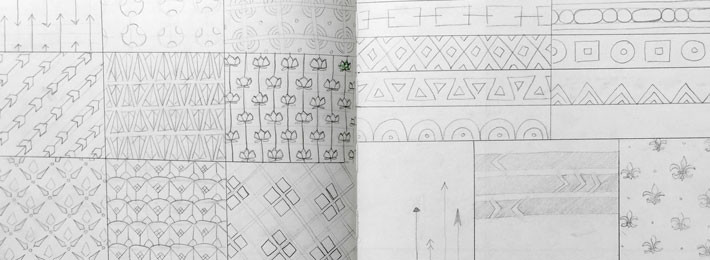Blog
Creating Repeating Patterns Without Tearing Your Hair Out

I decided to open an Etsy shop. I’ll be selling hand printed greeting cards and notebooks. The past few months have been filled with planning and researching (How do I open an Etsy shop? What do I sell? TAXES?!?!). But now comes the fun creative part: making patterns and designs to go on my cards and notebooks. I created some patterns previously for my Society6 shop but I needed a bunch more. (More about making patterns in More Pattern Talk and Poppy Flower Pods)
Thumbnail sketches
The process starts with thumbnail sketches (I’ll get into inspiration and research later). I divided my sketchbook page and filled in each box. The objective was getting everything out of my head — a pattern brain dump basically. I continued this way for a few pages then picked out the best ones to explore further. Next I drew out individual pattern elements in Sharpie to refine the shapes. Once I had those, I photographed each element to edit in the computer.
Editing pattern elements in Photoshop
- Remove color (Image > Mode > Grayscale)
- Adjust Levels
- Crop
- Remove white background (select > color range)
- Save
- Waste 10 minutes trying to create a repeating pattern in Photoshop.
- Remember it’s super easy to do in Illustrator.
Creating repeating patterns in Illustrator
- Place image (Wait. Didn’t I delete the white background in Photoshop?)
- Object > Image Trace > Make and Expand
- Remove white background
- Object > Pattern > Make
- Tweak pattern.
- Fill artboard with pattern (size of linoleum block).
- Tweak position of pattern (Illustrator > Preferences > General > Transform Pattern Tiles).
Why did I do this? Why didn’t I just draw directly on the linoleum? Did I create unnecessary work for myself? … Don’t question the process. I like the process. My brain likes the process… But seriously, hand-drawing and hand-carving a pattern already invites a lot of variety. I’m not a robot. I wanted to have a more uniform foundation to work from. The Process is all about minimizing variables and last minute adjustments.
Next up, making xerox copies and transferring the patterns to the linoleum.






